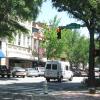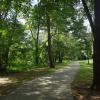Is ACC Finally Getting Serious About Pedestrian Safety?
On a typical day, more than 1,000 students cross Lumpkin Street adjacent to campus every hour on foot, making it the county's busiest pedestrian zone, and setting up potentially dangerous conflicts with car traffic. Accident data from the past five years show Lumpkin's hills to be the most dangerous areas—26 reported bike and pedestrian accidents— followed by Dougherty Street downtown and Prince Avenue between Pulaski and Barber streets, where, Athens-Clarke County Transportation Director David Clark told commissioners on Tuesday, car speeds are "still extremely high.”
And farther out on Lumpkin, 100 students jaywalk across the three lanes every hour to catch buses at Rutherford Street where there is no marked crosswalk. Similarly, on Milledge Avenue, mid-block jaywalking to bus stops is "very, very common," Clark said. He suggested a number of actions, some more expensive (and therefore "long-range") than others to reduce car/pedestrian conflicts: "No Drop-off" signs along Lumpkin; tweaking stoplights to give pedestrians a head start on turning traffic, or stopping all car traffic while pedestrians cross; a median "refuge island" for pedestrians halfway across Lumpkin and medians at bus stops on Milledge to prevent cars from passing stopped buses; removing sidewalk obstructions that can block views of pedestrians; placing pedestrian flashers overhead at crosswalks (not just at the side of the street); and moving Prince Avenue's crosswalks to better nearby locations.
On Lumpkin Street, "for all practical purposes, bikes are going down that hill as fast as a vehicle," Clark said, yet drivers will sometimes pass a bicyclist and then turn right in front of them, forcing a crash. He proposed adding a turn lane outside the bike lane and making bike lanes more obvious with a green thermoplastic coating.
Commissioners had ideas, too: ”traffic calming,” or intentionally slowing traffic down, by giving motorists "some kind of signal that you're in a town now," suggested Commissioner Kelly Girtz. Perhaps on Dougherty, a planted median could be added, and the street reduced to three lanes (even on-street parking could be added on that wide street, Clark suggested). "I don't think we can move forward with this without addressing [traffic] speed," added Commissioner Melissa Link.
"Why can't we put pedestrian islands on Prince?" asked Commissioner Jared Bailey, who thought Clark's solutions didn't go far enough. "The community has spoken pretty loudly that they want this to be a more walkable community." It'll take political will, he said, but "I'd like to see it go a lot farther."
But any changes will take money—perhaps $1.1 million to implement all his suggestions, Clark estimated. No such sum is now budgeted, but commissioners were interested in the prospects for a T-SPLOST (a regional transportation tax for specified projects, requiring voter approval) and asked for more details on Clark's proposals. The recently passed transportation funding law gives counties the ability to hold referendums on raising sales taxes for roads and transit. Meanwhile, commissioners gave an informal go-ahead for the lowest-cost changes: better signage and changes to signal timing.
When it comes to speed-limit enforcement, local police are somewhat hamstrung by state regulations. Not only does the Georgia Department of Transportation set speed limits on numbered highways that pass through town—including Broad, Milledge, Lexington Road and most of Prince Avenue—but GDOT also must approve (and has often denied) any change in speed limits on local streets, too. To discourage small-town speed traps, "the state legislature basically took setting speed limits away from local communities," Clark told Flagpole. And the way GDOT sets speed limits is not to try to adjust drivers' speeds to match conditions, but rather to see how fast drivers are already going and set the limit at a speed not exceeded by 85 percent of drivers.
The session was well-attended by the public (unusually so for a work session). BikeAthens Director Tyler Dewey told Flagpole that Clark's proposals "went much farther than past presentations," and he particularly liked adding the green finish to the Lumpkin bike lanes. But Prince needs bike lanes as well, he said, and noted that Clark himself had called it “feasible” a decade ago to reduce the intown portion of Prince to three vehicle lanes, adding two bike lanes. "The reason Prince is not five-laned currently is not because of engineering, it is because of politics," Dewey said.













comments